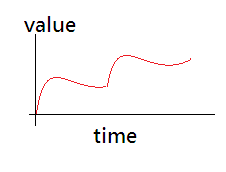
What are analog and digital signals? Explain with a diagram.
Answer
556.5k+ views
Hint: Analog signals are continuous signals in which one quantity which is varying with respect to time is represented. While digital signals use discrete signals which are discontinuous. Both of them are used to transfer information. The graph of analog signal is denoted as sine waves while the graph of digital signal is in the form of square waves.
Complete step by step answer:
First we will define both the types of the signals. Then we will mention some points of differences between them and then check which of them is more efficient.
Analog signals: An analog signal is a continuous signal. The analog signal is a continuous signal. Many devices use analog signals. In particular sensors typically output is an analog signal or voltage that varies based on something being sensed like light, heat or humidity.

Digital signals: A digital signal is the one in which the original information is converted into a string of bits before being transmitted over some channel. A radio signal is an example of digital signal. Digital signals are used to send information over long distances and these signals suffer less interference than analog signals. Digital signals are time separated signals which are generated using digital modulation.

It is clear from the above diagram that digital signal takes discrete values. Generally, these values are either represented as high-low or $0 - 1$ .
Additional Information:
WIFI signals are both digital signals as well as analog signal
Note:
Digital signals are non-continuous signals while on the other hand, analog signals are continuous signals . It is possible that some electrical component has both the signals. There are converters available which can convert analog signal to digital signal and vice-versa. Analog systems are of low cost and portable but they draw larger amounts of power. While digital signals draw negligible power but have high cost.
Complete step by step answer:
First we will define both the types of the signals. Then we will mention some points of differences between them and then check which of them is more efficient.
Analog signals: An analog signal is a continuous signal. The analog signal is a continuous signal. Many devices use analog signals. In particular sensors typically output is an analog signal or voltage that varies based on something being sensed like light, heat or humidity.

Digital signals: A digital signal is the one in which the original information is converted into a string of bits before being transmitted over some channel. A radio signal is an example of digital signal. Digital signals are used to send information over long distances and these signals suffer less interference than analog signals. Digital signals are time separated signals which are generated using digital modulation.

It is clear from the above diagram that digital signal takes discrete values. Generally, these values are either represented as high-low or $0 - 1$ .
Additional Information:
WIFI signals are both digital signals as well as analog signal
Note:
Digital signals are non-continuous signals while on the other hand, analog signals are continuous signals . It is possible that some electrical component has both the signals. There are converters available which can convert analog signal to digital signal and vice-versa. Analog systems are of low cost and portable but they draw larger amounts of power. While digital signals draw negligible power but have high cost.
Recently Updated Pages
Master Class 12 Business Studies: Engaging Questions & Answers for Success

Master Class 12 Social Science: Engaging Questions & Answers for Success

Master Class 12 English: Engaging Questions & Answers for Success

Master Class 12 Chemistry: Engaging Questions & Answers for Success

Class 12 Question and Answer - Your Ultimate Solutions Guide

Master Class 12 Economics: Engaging Questions & Answers for Success

Trending doubts
What are the major means of transport Explain each class 12 social science CBSE

Which are the Top 10 Largest Countries of the World?

Draw a labelled sketch of the human eye class 12 physics CBSE

How much time does it take to bleed after eating p class 12 biology CBSE

Explain sex determination in humans with line diag class 12 biology CBSE

When was the first election held in India a 194748 class 12 sst CBSE




